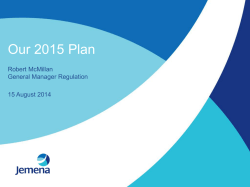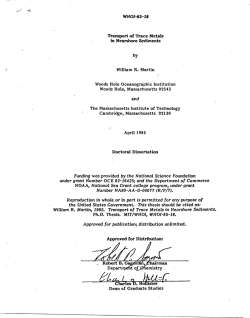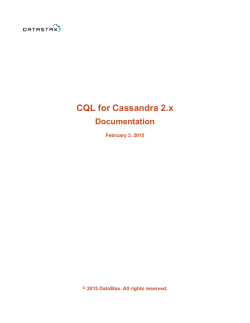
Monthly Fiscal Data December 2014
Fiscal Data Monthly revenues and expenditures of all subsectors of general government for December 2014 30 January 2015 Monthly fiscal data for the central government, local government and social security fund subsectors of general government 1. Background to Table 1 Introduction and purpose of the table As part of the Department’s drive to enhance fiscal transparency, estimates of revenue and expenditure of all sectors of general government are now published on a monthly basis. The publication provides timely data on the impact of each subsector of government; and by excluding financial transactions the table gives a different concept of balance than the traditional Exchequer borrowing requirement provided in the monthly Exchequer Statement. This publication, in addition to meeting the requirements of fiscal reporting and budgetary frameworks set out under the Enhanced Economic Governance package (the so-called ‘six-pack’), in particular Council Directive 2011/85 of 8 November 2011, provides further detail in terms of the composition of revenue and expenditure and the coverage of general government sectors, on a monthly basis. General government General government in Ireland comprises the sub-sectors central government (S.1311), local government (S.1313), and social security funds (S.1314). The CSO is responsible for applying the rules defining general government for Ireland. Table 1 shows the estimates of inflows and outflows for all sectors of general government. Flows between government bodies are detailed for each sector and consolidated in the second last column. The last column excludes flows resulting from financial operations and thus presents the consolidated non-financial flows of general government. The balance in column H does not purport to be equal to the general government balance. This is because the general government balance measures the balance of non-financial transactions of general government on an accruals basis. The balance in the final column of Table 1 is however indicative of the general government balance for the period. The first official estimate of the general government balance for 2014 will be published by the Central Statistics Office in April 2015. A detailed reconciliation table showing the steps from Exchequer balance to general government balance is shown at http://www.finance.gov.ie/sites/default/files/methodological%20reconciliation%20table%20fin.pdf Accounting basis The accounting basis for each subsector is included in the headings. The final three columns sum amounts on different accounting bases. Although this is unconventional, the intention is to give an indication of the impact of the transactions of each subsector of general government. Compilation of the data Some of the data in this table is provisional and based on the best estimates up to this point. The table will be updated each month and quarter when better data is available. The Exchequer data is based on the data presented in the Exchequer statement for the same period. Indeed the balance of the receipts and expenditures of the Exchequer data in Table 1, is identical to the Exchequer surplus / deficit in the Exchequer statement. The National Pensions Reserve Fund and Social Insurance Fund data are based on monthly surveys conducted by the statistics unit in the Department. Other central government bodies comprise extra-budgetary funds and non-market public corporations (non-commercial semi-State bodies). The most up-to-date list of general government bodies is shown at http://www.cso.ie/en/surveysandmethodology/nationalaccounts/. Data from these bodies are collected in a survey by the statistics unit in the Department. The government bodies that are included in this survey are chosen based on a materiality threshold and in particular focussing on those entities that have incomes independent of the Exchequer. The survey of central government bodies uses the calendar month as its reference period. The periodicity of data collection may be monthly or quarterly, however in either case the data is supplied on a month-end basis. For most bodies at the end of each quarter a survey form is issued requiring a monthly breakdown of receipts and expenditures (see template in Annex). For particular bodies with material and/or uneven monthly receipts and expenditures the data collection is conducted monthly. For example, the NPRF and the Risk Equalisation Fund are surveyed monthly. The survey form for each body is tailored to the activities of that body but is designed so that responses can be categorised into ESA classifications. Local government data is supplied to the statistics unit by the Department of the Environment, Community and Local Government in the format of Table 1. The local government data is available quarterly and before the end of the next quarter. The statistics unit also surveys the same central government bodies and the Department of the Environment, Community and Local Government for annual estimates of expected performance for the current and future years as part of the Excessive Deficit Procedure and Stability Programme processes. The current year annual estimates provide a control total for the monthly data. The survey of monthly receipts and expenditure in respect of these bodies for each full quarter is completed by the statistics unit before the publication date of that quarter. Therefore, the cumulative data included in Table 1 for extra-budgetary funds and non-market public corporations is based on actual data for each full quarter up to that point. For the first two months of each quarter, estimates for extra-budgetary funds, non-market public corporations and local government for the most recent months are based on previous years’ trends and information about expected performance in the current year. These estimates are updated when actual data becomes available. In summary, Table 1 to end December 2014 includes actual monthly receipts and expenditure data for the Exchequer, the National Pensions Reserve Fund and the Social Insurance Fund. Table 1 also includes actual receipts and expenditure data for extra budgetary funds and non-market public corporations. In addition, Table 1 includes actual data for the local government sector for Q1 – Q3 2014 and an estimate of the monthly receipts and expenditures for this sector for Q4 2014. Revisions The monthly tables are published cumulatively and any revisions that are needed to be made to earlier months’ data are incorporated into the cumulative estimates. Conventions used The following conventions are used : “-“ is used to denote zero “0“ represents less than €0.5 million but more than zero A blank cell refers to a structural zero Note also that rounding may affect totals Table 1: Monthly Fiscal data for the central government, Social Insurance Fund and local government subsectors of general government (€m) At end-December 2014 ESA code accounting basis 1 Total revenue / inflows S.1311 Central government NPRF & CG Exchequer ISIF bodies A B C S.1314 SIF D S.1313 Local gov't E S.13 General gov't F (= A to E) S.13 cash mixed mixed cash accrual mixed consolidated transactions S.13 General gov't H cons'd excl. fin ops General gov't G 53,356 131 8,675 12,632 5,683 80,477 62,810 61,666 Direct Taxes (taxes on income & wealth) D.5 22,405 - 1,205 - - 23,610 23,610 23,610 Indirect taxes - VAT D.2 11,153 - - - - 11,153 11,153 11,153 other indirect taxes D.2, D.9 7,724 - 1,062 - 1,561 10,348 10,348 10,348 Social contributions D.61 - - - 7,870 - 7,870 7,870 7,870 Property income D.4 750 112 238 - 58 1,158 1,158 1,158 Other receipts 4,567 19 878 8 2,054 7,527 7,527 7,527 Inflows from S.1311 (central gov't) 1,107 - 5,175 754 1,863 8,899 Inflows from S.1313 (local gov't) 196 - 87 - - 282 Inflows from S.1314 (SIF) 467 - - - - 467 Inflows from operations in financial instruments 4,987 - 30 4,000 146 9,163 Of which consolidated with other govt bodies 4,019 - - 4,000 - 8,019 61,539 10 8,628 12,647 5,603 88,426 70,759 69,475 14,050 0 1,015 - 1,728 16,793 16,793 16,793 2 Total expenditure / outflows 1,144 Compensation of employees D.1 Interest D.41 7,466 - 111 - 15 7,591 7,591 7,591 Social benefits D.6 14,262 - 763 7,956 446 23,427 23,427 23,427 Capital transfers (capital grants) D.9 - - 200 - 76 276 276 276 Other expenditure 14,392 9 3,780 209 2,997 21,388 21,388 21,388 Outflows to S.1311 (central gov't) 4,843 0 1,439 467 282 7,031 Outflows to S.1313 (local gov't) 612 - 1,251 - - 1,863 Outflows to S.1314 (SIF) 754 - - - - 754 Outflows from operations in financial instruments 5,160 - 69 4,015 59 9,303 Of which consolidated with other govt bodies 4,000 - 4 4,015 - 8,019 -8,183 121 47 -15 80 -7,949 A. Overall balance (1-2) 1,284 -7,949 -7,809 2. Explanatory notes Table 1 shows the receipts and expenditures of all arms of government for the year to December 2014. The table is set out to show the transactions of each of the subsectors of general government separately and to show the Exchequer separately from other central government bodies. The ESA codes are the transaction codes from the European System of Accounts (ESA). The table identifies transactions to particular ESA codes where applicable. It should be noted, however, that this classification is not exhaustive and many transactions may be classed as ‘other’ which may be more precisely classified to particular ESA codes in the annual and quarterly tables produced by the CSO. 2.1. Transactions (rows of the table) Taxes Direct taxes are taxes on income and wealth and include: income tax, corporation tax and capital gains tax. Direct taxes also include the household part of motor taxes, local property tax levied on vacant homes, and the National Training Fund levy. For international comparison purposes VAT is detailed separately in this table. Indirect taxes are taxes on products and production taxes. These include: customs; excise; stamp duty; the local property tax (excluding vacant homes); local authority rates; the non-household part of motor tax; the risk equalisation levy; and capital acquisitions tax. Some taxes are collected by central government bodies outside the Exchequer. These are shown in column C of the table and include motor tax, National Training Fund levy, the risk equalisation levy and National Oil Reserve Agency levies. Social contributions The social contributions in this table comprise all PRSI payments to the Social Insurance Fund from employers, employees and self-employed. Property income Property income includes dividends and interest income from State-owned entities. Other receipts Other income includes appropriation-in-aid, other non-tax revenue to the central fund and receipts of other government bodies. Compensation of employees The figures for compensation of employees in this table aggregate the pay items from the central fund voted expenditure as well as pay categories of other general government bodies and subsectors. Interest This is the interest component of Exchequer current expenditure as well as estimates of interest costs of other government bodies. Social transfers Social transfers include all voted expenditure on pension payments; jobseeker’s allowance; child benefit; disability allowances and selected other targeted payments to households. Also included in this category are benefit payments made from the Social Insurance Fund. Inflows and outflows from other government bodies The flows between government bodies are consolidated in the second last column. Flows from operations in financial instruments The table identifies loan and equity transactions as financial transactions. Flows resulting from financial transactions do not change the net financial worth of government. These flows are excluded in the final column of the table. 2.2. General government sub-sectors (columns of the table) The tables show estimates of the receipts and expenditures of the three subsectors of general government in Ireland. Central government In the case of central government the table splits out, in columns A to C, the Exchequer or central fund flows from flows of the National Pensions Reserve Fund and other central government bodies such as extra-budgetary funds and non-commercial semi-state bodies. Examples of the latter bodies are the local government fund and Enterprise Ireland. Column A shows the receipts and expenditures of the Exchequer. While the balance in column A is identical to the Exchequer surplus / deficit in the published Exchequer Statement, the total receipts and total expenditure may differ in the two publications. The difference relates to the sinking fund which is excluded from the monthly tables and also the presentation of voted expenditure. The Exchequer Statement presents the net voted expenditure, i.e. the total expenditure less appropriations in aid received by the various Departments. The monthly table includes the gross voted expenditure. The balance in column C shows the excesses of receipts over expenditures of central government bodies. Because monthly payments into certain funds may not have the same monthly profile as payments out of the fund, there may be months where the balance is significant. This may not be indicative of the end year position. Other subsectors of general government Column D and E show the inflows and outflows of the Social Insurance Fund and local government. All general government Column F sums column A to column E and thus gives a measure of the inflows and outflows of the whole of general government. It is to be noted however that the total revenue and total expenditure include flows between government units. This is therefore an unconsolidated measure of the flows of general government. Consolidated general government The sum of the inflows from other government units in column F is equal to the sum of the outflows to other government units. These flows are marked with brackets in the table. These flows are omitted in column G arriving at a consolidated view of receipts and expenditures of general government. Consolidated transactions of general government excluding financial operations Column H is arrived at from column G by excluding all flows resulting from operations of financial instruments. The total revenue and total expenditure in column H only include non-financial transactions with entities outside government. The balance in column H is the balance of revenue and expenditure in that column. Rationale and interpreting the consolidated balance of nonfinancial transactions The rationale for excluding flows relating to financial instruments is that unlike other transactions such as tax receipts or interest payments, financial transactions such as equity acquisition and loans do not change the financial net worth of government. The accounting basis in Table 1 is generally on a cash basis. Consequently, this measure is not equal to the general government balance. As mentioned above, the consolidated transactions of general government excluding financial operations is indicative of the general government balance for the period. 3. Commentary on the figures FEOGA and supply account loans In this period the Central Fund received €715m in loan repayments from the FEOGA scheme (financing direct payments to farmers under the Common Agricultural Policy) and a €153m repayment from the supply account for advances made at the end of 2013 to meet early payments in January 2014. These flows are shown in note 3 of the December 2014 Exchequer statement and are included here under inflows from operations in financial instruments. The Central Fund provided a loan to FEOGA of €677m up to December 2014. The Central Fund also provided repayable advances of €198m to the supply account to meet early payments in January 2015. These transactions are shown in Note 6 of the December 2014 Exchequer statement and are included here under outflows from operations in financial instruments. Transactions between the central fund and the Social Insurance Fund The central fund provides a short term loan facility to the Social Insurance Fund to meet in-month cash needs. In January 2014, €15m was paid in to the central fund on a loan given in December. Further loans amounting to €4000m were provided up to December 2014. In total, €4015m has been repaid by the Social Insurance Fund to the Exchequer. These flows are shown in notes 3 and 6 of the December 2014 Exchequer statement and are included here in the categories of financial instruments consolidated with other government bodies. It is worth remarking that apart from these loan transactions, the Social Insurance Fund is in balance in December 2014. As well as the loan facility agreement there are other payments between the Exchequer and the Social Insurance Fund. These payments are part of net voted expenditures in the Exchequer statement and are shown in Table 1 as inflows / outflows between the Exchequer and the Social Insurance Fund. Bank guarantee scheme Income of €179m to the central fund from credit institutions under the Eligible Liabilities Guarantee is shown under the heading ‘other receipts’. In July 2014, the central fund received interest of €200m relating to the holding of contingent capital notes. National Lottery Licence Payment A total of €405m relating to the National Lottery Licence Payment was received during this period. This shown under the heading ‘other receipts’. Insurance Compensation Fund A €100m repayment of the State advance to the Insurance Compensation Fund was received in April 2014 and is recorded under the heading ‘inflows from operations in financial instruments’. Central Bank Surplus Income Income of €1.2 billion relating to Central Bank surplus income was received in the central fund in May 2014 and is shown under the heading ‘other receipts’. Transfer of Local Property Tax Receipts to Local Government Fund During 2014, €483.6m relating to local property tax received in the central fund was transferred to the local government fund as provided for in the Finance (Local Property Tax) Act 2012. This transaction is recorded as flows to / from S.1311 (central government). Receipt of Motor Tax from the Local Government Fund In December 2014, the Central Fund received €520m in respect of motor tax receipts from the Local Government Fund as provided for in Section 6 of the Local Government Act, 1998, as amended by Section 79 of the Local Government Reform Act 2014. This transaction is recorded as flows to / from S.1311 (central government). 4. Annex Survey Form Receipts & Expenditures of General Government, Non-Market Public Corporations Department of: XXX Name of body: YYY January-March 2014 A. Receipts & Expenditures Jan Feb Mar Apr May Jun Jul Aug Sep Oct Nov Dec €m €m €m €m €m €m €m €m €m €m €m €m 0.0 0.0 0.0 0.0 0.0 0.0 0.0 0.0 0.0 RECEIPTS Receipts from Exchequer EU Grants Turnover Other (Please specify in Sec.B) EXPENDITURE Pay Pensions Other admin. Industry Development Other (Please specify in Sec.B) Receipts less Expenditures 0.0 0.0 0.0 B. Explanations or additional information C. Sign-off 1. The information contained above is correct and complete to the best of my knowledge 2. Appropriate control, checking, and review procedures have been applied to the above information to ensure its accuracy 3. Other than items referred to above in the “Explanations or Additional Information” Section, there are no unresolved issues, new items, items where treatment is uncertain or items you wish to discuss further with us Return completed by: Name: Position: Organisation: Email/Tel: Date:
© Copyright 2026




